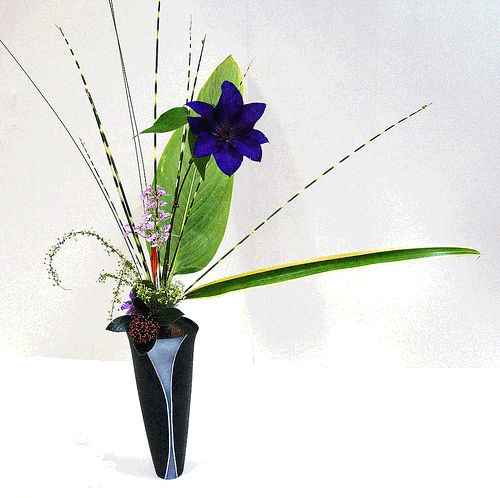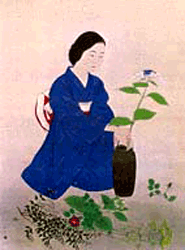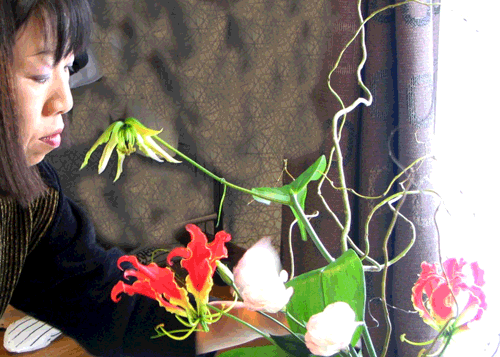THE SPIRIT OF IKEBANA
by Alain DELAYE

Ikenobô, the most ancient school, still teaches traditional styles like rikka and shôka. It remains faithful to the asymmetric triad and to the idea of Ikebana as spiritual exercise.
Ohara, more recent, has abandoned traditional rikka and shôka, but has restarted a modernised form of moribana, and renewed, if not with the form, at least with the spirit of landscape which animates the rikka. It has also opened out to abstraction and to western flowers as well as to modern methods of teaching.
Sôgetsu, the most revolutionary, the least rooted in Japanese tradition and the nearest to western floral art, appeals more to the subjectivity of the artist and takes more freedom in the choice of forms and materials.
Here are texts of some great masters of these schools, which testify to their spirit :
“Very early in history of Japan, a logical relationship was created in which man and nature were envisaged as a unity, where the life of man and that of the flower were undissociable. This attitude – fruit of the original shintô, of Buddhism and finally of Confucianism – has played an important role in the formation of Japanese individuality. One of the numerous consequences of this attitude has been to give rise to a profound study of flowers, of their essence and their nature, as well as the formation of a tradition of understanding concerning them.”
Sen’ei Ikenobô
“Moribana, as much the traditional as the modern, seemed to us, for a long time the best vehicle of floral creation, but we would willingly say that whoever desires to express himself by this creative technique must first of all look at nature – this nature within which we live and which, she too, lives in us. No matter what materials are used – flowers from the florist, simple flowers from the garden or even weeds or plants without flowers – the essential is that the arrangement created testifies to a sincere observation and a real understanding of nature : it is there the very centre of the real spirit of Ikebana.”
Houn Ohara
“Ikebana is something very different from the simple act of decorating with flowers. It gives us much more than a setting for the table or tokonoma. It brings art. And we model these living things just as the sculptor moulds clay or plaster… It is at that moment that the miracle occurs. A handful of flowers, a tray of leaves becomes something other than the simple total of its elements. Flowers and stalks have been combined and as if recreated into something new, in one ikebana which expresses at the same time the spirit of flowers and the heart of its author. Humanity has penetrated the world of nature and has drawn from it this work which becomes object of contemplation.”
Sôfu Teshigahara
We have, in the preceding lines, evoked Zen several times. It is because this branch of Buddhism is at the source of Japanese floral art as a way of wisdom. This art aims to be more than a decorative activity, it wants to lead to a certain harmony, and it is in this way that all its masters have understood it since the first Buddhist monks who have invented it, until the founders of modern schools. The wisdom of Zen, with which Ikebana is bound, aims to make the user conscious of his insertion in a mystery of life, which carries him and surpasses him.
All beings in the universe take part in a community of existence, dig their roots into the same earth, and participate in the same Being. Zen does not ask us to reflect about this rooting, but to experiment it, fulfilling an interior harmony. To do that, it puts into action the techniques of meditation like zazen, koans, but also the decorative or martial arts, which present between them many analogies. It is in this way that the basic styles of Ikebana are, like the katas of martial arts, matricial structures in which the artist can melt and dispossess himself from his individual reactions. The «I» fades away, leaving place to the apparition of a more profound energy. As writes D.Richie : “If the aim of the Japanese bouquet is really to make the flowers alive, that the arrangement suffices to itself whilst symbolising all the flowers of this world, one cannot fail to grasp that an impulsion, a kind of «ki» – total immersion of the creator in his creation – is something absolutely necessary.
 When making a bouquet, the ikebanist creates a micro-world. Doing that, he refers to the creation of the world, he identifies himself with the origin, with the source of the universe, and the energy which traverses and inspires him in his creation tends to mime that which presides the deployment of the cosmos. The fruit of his work, modest as it may be, is a microcosm connected to the infinite of the world by invisible links, which bind at its centre all the points of the universe. Unbounded vision, will one say ? Not for he who understands that a Japanese bouquet, if structured according to the triad sky-man-earth, or unified in the monad of a chabana, symbolically expresses the cosmic wholeness and celebrates the union of visible and invisible. In doing that, he only realises the project of every work of art such as Schelling evokes it : “The most eminent effect of art is to catch and measure in a single look the absolute greatness, the infinite in itself, catching it in the finitude.” And such as Valéry describes it : “Being spatially limited, the work of art represents the model of an unlimited world… a finite model of an infinite world… the work of art is in principle the reproduction of the infinite in the finite.”
When making a bouquet, the ikebanist creates a micro-world. Doing that, he refers to the creation of the world, he identifies himself with the origin, with the source of the universe, and the energy which traverses and inspires him in his creation tends to mime that which presides the deployment of the cosmos. The fruit of his work, modest as it may be, is a microcosm connected to the infinite of the world by invisible links, which bind at its centre all the points of the universe. Unbounded vision, will one say ? Not for he who understands that a Japanese bouquet, if structured according to the triad sky-man-earth, or unified in the monad of a chabana, symbolically expresses the cosmic wholeness and celebrates the union of visible and invisible. In doing that, he only realises the project of every work of art such as Schelling evokes it : “The most eminent effect of art is to catch and measure in a single look the absolute greatness, the infinite in itself, catching it in the finitude.” And such as Valéry describes it : “Being spatially limited, the work of art represents the model of an unlimited world… a finite model of an infinite world… the work of art is in principle the reproduction of the infinite in the finite.”
But this, one sees, concerns many forms of artistic creation. Ikebana has this specifically that it uses elements drawn from the vegetable world. It reorganises the first floor of the living world and prolongs the architectural nature. That the animal stage be out of its preoccupations coincides certainly with practical imperatives. What the painters of flowers in the XVIIth and XVIIIth centuries did, introducing animalcules in their bouquets (slugs, insects, lizards…), one does not see how the ikebanist could do it. But, more profoundly, one can discern in this person, the desire to return to a calm, pacified nature, to a nature which existed before the mobility and animal agitation. The vegetable world is not as conflicting and tormented as the animal world. Concentrating, meditating on it, the ikebanist affirms his desire of refinding an original peace, a serenity of before running and crying. In this way, he is faithful to his Buddhist inspiration, for, if the vegetable life is an entire and complete life – and indispensable, what would we be without it ? – It is also the image of a human pacified life, without sufferance, that means, according to Buddhism, an achieved life.
In Japan, during centuries, Zen has been at the core of numerous approaches, and the master of archery, like the master of calligraphy, of ceremony of tea or of floral art, is the one who, in his own discipline, and thanks to it, has been able to realise his personal harmonisation with the universe and all beings. So, Ikebana is a plant which has bloomed in the earth of Zen and still constitutes today one of the ways by which this wisdom can be obtained : “The way of flowers” says prettily Gusty Herrigel. Here it is, poetically evoked by two great Zen masters :
“A flower blooms
Spring is over the whole earth”.
Lin Tsi
To see in one’s own nature
Is to see by oneself
The true face of the lotus.
Hakuin
But Ikebana does not mean only an interior approach, it is also in Japan a means of social communication as it is put in evidence by the ceremony of flowers which is still practised in some traditional circles like the ceremony of tea. Like this, that occurs between a host and a guest.
For a first moment, the guest meditates before the niche (tokonoma) where the floral composition and the picture (kakemono) are placed, prepared by his host. Then, he gives his whole attention to the composition to impregnate himself with the spirit, which inspired its realisation.
In a second time, the host invites his guest to make a bouquet himself. He gives him material for that and then withdraws. Then, the guest kneel, crouches down on his heels, and examines the plants and the vase, which has been trusted to him. Looking at them, he allows an inspiration to arise in him, which is going to guide his work. This lasts the time necessary. Finally, the host invites his guest and his family to come and admire the work. Everybody places themselves in a semi-circle around the two bouquets and contemplates them in silence, trying to communicate with what their authors have wanted to express.

Today, these traditions are falling into disuse and Ikebana becomes, even in Japan, the object of a mercantilism, which creates a void from its original spirit. This spirit of which Bashô has so well spoken : “As regards art, it is fitting to follow the creative nature and to make the four seasons our helpmates. Of all that we see, there is nothing, which is not flower, of what we feel, nothing which is not moon. Who in the forms sees not the flower is like a barbarian. Who in his heart does not feel the flower is like a brutal beast. Leave behind barbarity, keep away from bestiality, follow nature and return to nature !”
“Of what we see, there is nothing which is not flower”.
In this way, the greatest Japanese poet identifies the world, the entire nature, to a flower. For him, to follow nature and to feel the flower is the same thing. No doubt, it is to this cosmic symbolism of flowers that one must turn to understand the importance of Ikebana in the traditions of floral art.
– This text is translated from the book of Alain Delaye : Les fleurs dans l’art et la vie (Éd. l’Originel, 5 passage de la Folie-Regnault 75011 Paris) . To practice Ikebana in France, see : Centre Ikebana, 26 rue d’Armaillé, 75017 Paris, tel 01 45 74 21 28.
– By the book Les fleurs dans l’art et la vie




